Terrific Times in Tokyo
Tokyo is indeed an urban jungle, but it has something for everyone
COUNTRIES
Getting to Tokyo from Kyoto was about as easy as cutting butter with a hot knife. If you consider that the capital was moved from Kyoto to Tokyo, it starts to make sense. When the emperor moved to Tokyo (Tok=east yo=capital), he would require his lieges, most of whom still lived in or near Kyoto, to make a trek to Tokyo twice annually. This in turn required decent infrastructure for making such a journey and resulted in a series of high quality roads running between the two capitals. The shinkansen today follows roughly the same route as those old roads. It also runs right alongside Fuji, and granted us a look at the famous mountain! We arrived a few hours later without incident to the famous capital, home to roughly 33 million people.
Afterwards, we made our way to the Imperial Palace, which was similar to Osaka in that it has a wide running path around the perimeter outside a moat and castle walls (I was fortunate to get three runs in during our stay). While the palace itself is largely off limits without a specially scheduled tour, the East Gardens of the palace grounds is open to the public. The Gardens had a free, app-based audio tour (much to Dana’s delight) and concluded at a lovely Japanese garden and koi pond.
That evening we made our way to the Tokyo Sky Tree for a sunset view of the majestic city. The Skytree is 3rd tallest building in the world as of this writing and the views over the endless city lights of giant Tokyo were reeling. The Skytree is built to be earthquake-worthy and thus able to bend without breaking and we could swear we could feel the sway as we walked around the observation floor.
The remainder of our trip was primarily spent meeting up with friends of mine who live in Tokyo, some from my childhood days in Yokota (Devon), some from New York (Debbie and Pau), and some from grad school (Tetsuro and his lovely wife). It was a trip highlight to see so many friends and their families after so many years of restricted travel?
Our stay in Tokyo was based in Tsukiji, but we were also walking distance from the ritzy Ginza neighborhood and ended up heading that way for our first evening in the new city. We are shocked by the amount of upscale shopping, high-end cafes, and well-appointed office buildings there were. It felt much like 5th Ave in New York. While Ginza was upscale and snazzy, Tsukiji was a bit gritty and considerably more down to earth. This neighborhood is famed for its fish and outdoor market close to the harbor but we understood the fish market had moved somewhere else a few years back1. So, the next morning, we were a bit surprised to find throngs of tourists on the back-alley streets nearby. They were there for the food--oon food tour, seeking the famed sushi of the old fish market, which still turns out to have significant but manageable sized fish-based food stalls and restaurants. Grilled, barbecued, and fried fish vendors lined the alleys nearby. I had a delightful tuna and rice bowl for breakfast!
Footnotes:
1) The Tsujiki Market is actually credited with started the world's sushi craze (I even had sushi for breakfast here!) and was once the largest fish market in the world. However, the market became outdated, built around the old rail system but difficult to access for freight trucks and meet modern cleanliness and safety standards. After many years of planning, the main bulk of the fish market was actually moved a few miles away to Toyosu in the 2000's. Today Tsujiki has a much smaller and more manageable fish market, perfect for the waves of tourists that come through on tours or alone to try out its tasty wares.
2) On this trip we have taken strongly to listening to podcasts or audiobooks on our long walks. On this walk, I specifically recall listening to the Revisionist History podcast at this point where they were giving the history of hunger studies done during WWII- absolutely fascinating. I highly recommend a listen.
Despite having lived in the region as a child, I don’t think I grasped Tokyo’s geography, in particular the number of rivers cutting across the city. On one of our last days, Dana made plans for us to take a local river cruise, that runs south on the Sumida River and ends at the beautiful Hamarikyu garden. This garden was originally a Falconry for the samurai elite and had lots of bits and pieces left over from that former use. After a relaxed walk around listening to a podcast together2, we stopped in at a fairly traditional teahouse by the water and enjoyed matcha green tea (still quite bitter and chalky) in a very serene environment.
We took another tour the next day from the same company. This one a night tour in Shinjuku which was about as different as possible, focusing on the red lights district, night life, and prominently featuring the incredibly busy Shinjuku station (which has something like eight major subway and train lines going through and serves more than 3.2 million people a day), and the famed ‘piss alley’, a tiny street/alleyway full of micro bars and diners named for the actions resulting from a lack of urinals historically available. It has improved its presence significantly since gaining that name, and apparently is the sister alley to one in Osaka. Looking back on the tour and its crowded streets, we couldn't help reflect on the similarly tiny alley in Itaewon, Korea, where more than 150 people died in a panicked crush during Halloween celebrations.
Both tours provided an opportunity to meet and chat with other travelers. On the first, we met another couple from Denver on a similar multi-month travel around the world! On the second, we met two Ukranian women, who were completing medical studies in Japan, as the country had opened its doors to students to come and complete their studies safely while the country is still at war.
Near the end of our time here, we decided to go to futuristic Daiba Island, which is accessible via transit line that soared high above the city streets several stories before carrying you across to the island. Daiba most recently hosted several sports for the 2020 Olympics in Japan but is better known as a tech and science hub. From there we went to the Emerging Science Museum, with a variety of interesting and sometimes bemusing exhibits on new age science and cutting-edge scientific questions, from robots to AI facial development to climate change to stem cell research. We also enjoyed a nice walk along the island shore, which was blessedly quiet after many days of big crowds most places we went.
With that we made our way to Narita airport on a long day of travel to Malaysia to start month three of our adventure!
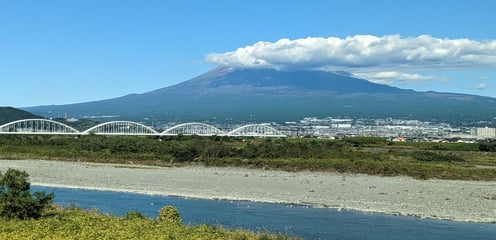

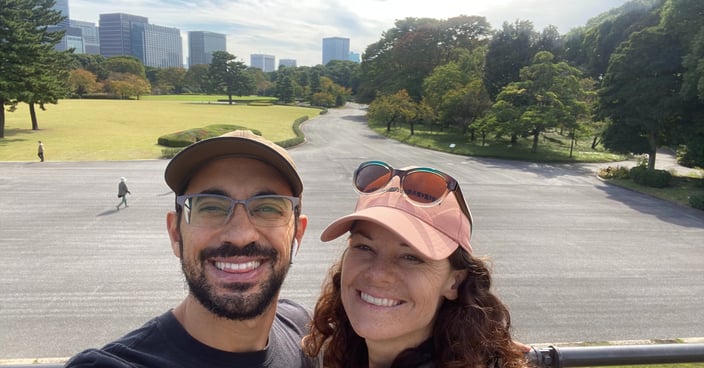

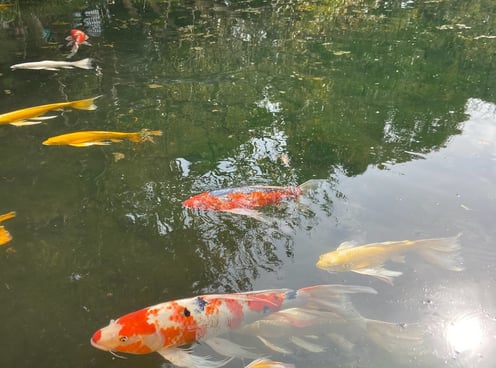

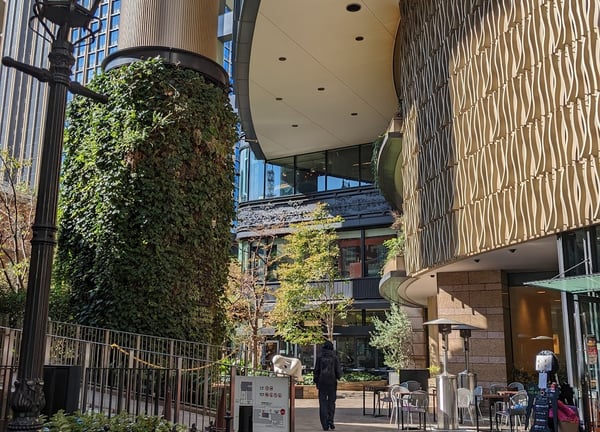

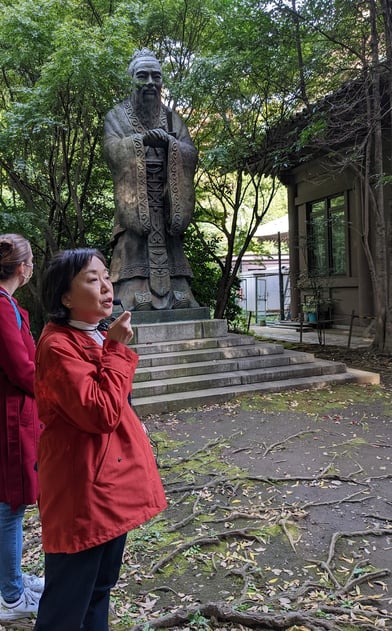

Tokyo has a wealth of free (aka donation based) walking tour--one of our favorite activities while traveling. We had two booked while in in the city and began our first in another famous neighborhood called Akhiabara, once known for selling electronic parts secondhand from US military equipment and today for selling all things video games, anime and manga. Our lovely tour guide Yumi, a middle-aged Japanese woman gave a tour which was full of not only historical details of specific neighborhood but also societal reflections. She notably brought up paid time off (Japan doesn't give much, although still more than the US standard 2 weeks) and aging populations (Japan has a famously aging population, and Yumi herself doesn't have kids, attributing some of this trend to costs and some to a culture very focused on work and career).
The tour took us to a Shinto Shrine, where we finally learned a bit more about Japan's native religion, which is quite distinct from most of the world's popular religions today, as it has no real "gods" and does not prevent practicers from also following other religions like Buddhism. We ended in lovely Ueno Park, the largest urban park in dense, concrete heavy Tokyo.
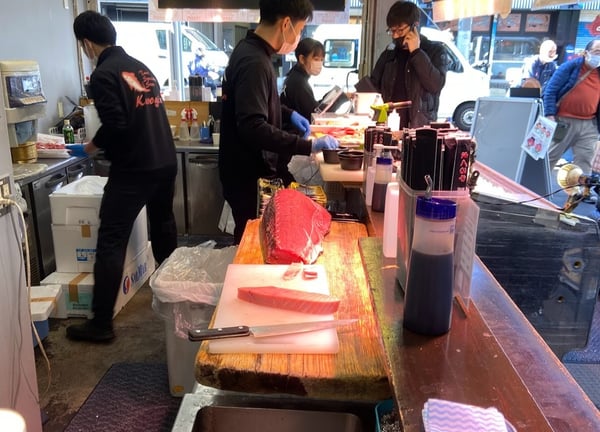

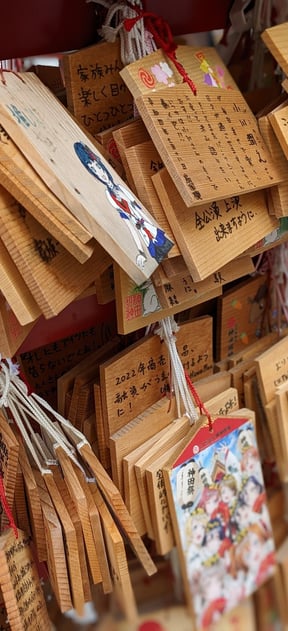

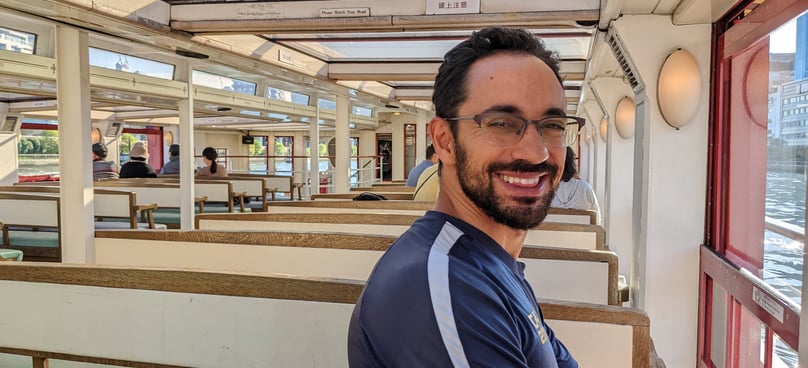

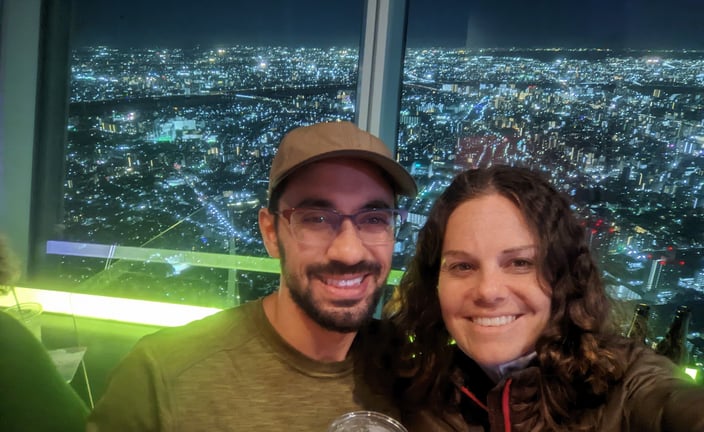

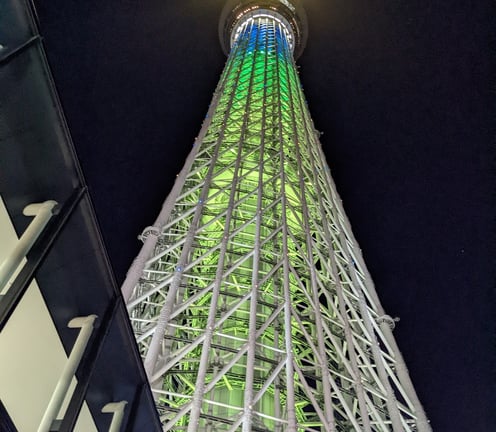

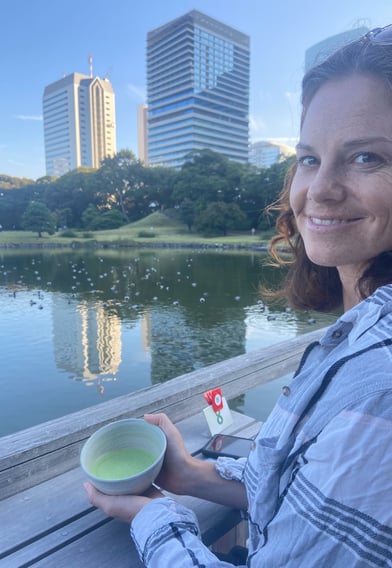

Above: the wide joggable dirt paths of the palace and the specially bred fishies of the east garden. Below: SkyTree Tower from below and up high.
Yumi talking about a Confucian shrine on our tour.
At shinto shrines you can buy and write wishes on these wood blocks.
Shadie on our water taxi and Dana enjoying the view at Hamarikyu garden a bit more than the matcha tea itself.
Keep in touch!
The glitsy buildings of Ginza and the tasty sushi of Tsukiji.
Mount Fuji in the distance!
